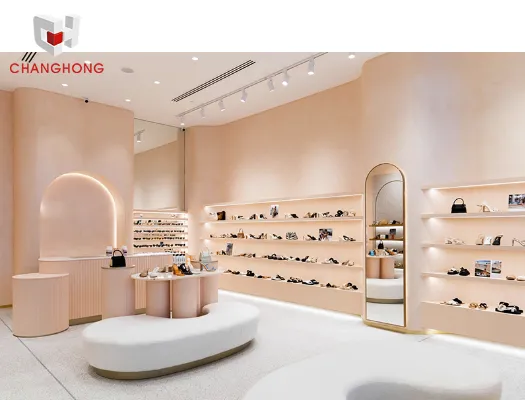- 150m Southwards, West DingWei Road, Nanlou Village, Changan Town, GaoCheng Area, Shijiazhuang, Hebei, Suav
- monica@foundryasia.com
Jul . 21, 2025 13:51 Rov qab mus rau npe
Showcasing Style and Driving Sales: The Power of the Right Shoe Display
In footwear retail, presentation is everything. A customer's decision to pick up a pair of sneakers, stilettos, or boots starts not with a sales pitch—but with how those shoes are displayed. A smart, attractive shoe display doesn't just hold your products—it tells a story, elevates perceived value, and drives conversions.
Whether you're running a fashion-forward boutique, a high-volume sports retailer, or a luxury shoe store, the right shoes shop display setup can transform the shopping experience and help your merchandise move faster.
In this guide, we break down the types of displays that work, the importance of materials and layout, and how a well-designed performance shoe shelf can highlight key SKUs and boost your bottom line.

Why Shoe Displays Matter More Than You Think
Footwear shoppers are highly tactile. They want to touch, try on, and inspect. Before they even do that, though, they scan the display.
A good shoe display does the following:
Captures attention through style, lighting, and positioning
Encourages discovery with clear segmentation (e.g., men’s, women’s, kids’)
Highlights performance or luxury features
Supports storytelling (think lifestyle scenes or brand campaigns)
Maximizes space without clutter
Aligns with your brand image
In short, your display is a silent salesperson. Get it right, and you create a space that sells even when staff are busy.
Types of Shoes Shop Display Solutions
Depending on your store size, brand aesthetic, and inventory volume, you have multiple shoes shop display options. Most retailers use a combination of these for best results:
1. Wall-Mounted Displays
These vertical shelving systems are great for organizing large stock lines. They’re adjustable, space-saving, and ideal for maximizing perimeter walls.
2. Slatwall & Gridwall Accessories
Perfect for modular merchandising. Add hooks, shelves, or angled brackets to change up the display based on product size and season.
3. Tabletop Displays
Low-rise, freestanding tables at the store’s center highlight new arrivals or curated collections. Use acrylic risers or stepped displays to create depth.
4. Freestanding Towers or Islands
Use these for bestsellers, seasonal promos, or premium lines. Position in high-traffic zones to trigger impulse interest.
5. Performance Shoe Shelf
These are specially designed for athletic or technical footwear. They often include:
Angled displays to showcase outsoles
Built-in info cards (e.g., cushioning tech, drop height)
LED lighting to emphasize colors or materials
Reinforced materials for heavier stock (e.g., hiking boots)
What Is a Performance Shoe Shelf?
A performance shoe shelf is engineered specifically for displaying athletic, hiking, running, or sports-specific footwear. These aren’t just basic platforms—they’re designed to:
Showcase tech specs visually
Highlight sole traction and grip via angled positioning
Withstand weight and constant handling
Help customers compare models side by side
They're common in stores that sell running shoes, trail shoes, cleats, or court-specific designs. When used well, a performance shelf not only educates—it sells.
Material & Design Considerations
Choose display materials that reflect your brand while holding up to daily use:
|
Khoom siv |
Best For |
Features |
|
Wood |
Boutiques, lifestyle brands |
Warm, upscale, versatile |
|
Metal |
High-traffic, commercial use |
Durable, modern, weight-bearing |
|
Acrylic |
Pop-ups, seasonal promotions |
Lightweight, clear, clean look |
|
Glass |
Luxury footwear |
Elegant, minimal, best for high-end |
|
Composite panels |
Performance and sports brands |
Practical, easy to clean, lightweight |
Lighting also matters. Use focused spotlights, LED strips, or under-shelf lighting to draw attention to key models—especially in dark or neutral colorways.
Shoe Display Mistakes to Avoid
Overcrowding: Showcasing too many styles at once creates visual fatigue.
Poor lighting: Dulls the product, especially in dim corners.
No clear hierarchy: Bestsellers and hero products should stand out.
Mismatch with brand identity: Rustic wood shelves in a tech sneaker store? Doesn’t work.
Ignoring accessibility: Bottom rows should still be visible and reachable.
Pro Tips for a High-Converting Shoe Display
Use tiered levels to create visual flow (eye-level always sells best).
Rotate displays weekly to keep returning customers engaged.
Integrate signage with product features (e.g., “New Drop,” “Lightest Runner,” “Waterproof”)
Mirror usage: Strategically placed mirrors can draw customers deeper into the store.
QR codes: Let customers scan for product info or available sizes online.
Shoe Display FAQs
Q1: What’s the ideal height for a shoe display shelf?
A: Eye level (around 140–160 cm from the floor) is prime real estate. Arrange top sellers here. Use lower levels for overflow or stackable inventory.
Q2: Can performance shoe shelves be customized for brands?
A: Absolutely. Many brands request custom-molded or branded display units that include logos, graphics, and LED lighting built into the shelf design.
Q3: How often should I update my shoes shop display?
A: Ideally, update seasonally or with each product drop. Smaller changes weekly (like moving displays or signage) help keep the layout fresh.
Q4: What’s the best material for long-term display durability?
A: Powder-coated steel or high-quality laminates offer excellent longevity without showing wear. Wood is beautiful but may need more maintenance.
Q5: Do I need a shopfitter to build a performance shoe shelf?
A: For custom or high-volume displays—yes. For modular shelves or small spaces, many retail display systems are DIY-friendly.
-
Square Cast Iron Cookware Picks
Xov xwmJul.21,2025
-
Seasoned Cast Iron Grill For Everyday Cooking
Xov xwmJul.21,2025
-
Preseason Cast Iron Made Easy
Xov xwmJul.21,2025
-
Pre Seasoned Cast Iron for Daily Cooking
Xov xwmJul.21,2025
-
Cast Iron Wok Cooking Power
Xov xwmJul.21,2025
-
Cast Iron Grill Pan For Stovetop Use
Xov xwmJul.21,2025